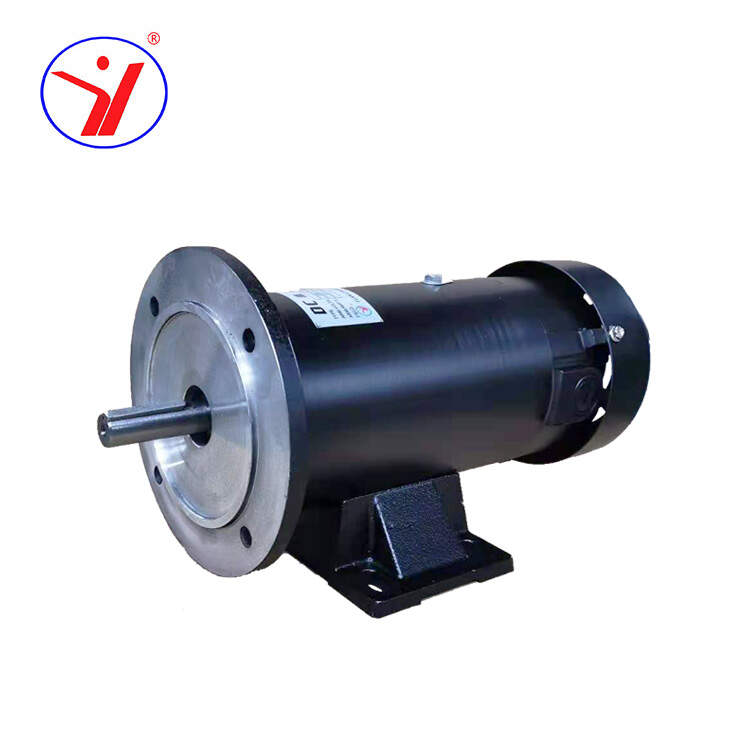Unveiling the Power of 24 Volt Permanent Magnet DC Motors
In the world of electromechanical systems, the 24-volt permanent magnet DC motor stands out as a versatile powerhouse. Its compact design, efficient operation, and precise control make it a preferred choice across a spectrum of applications. Let's delve into the intricacies of these remarkable motors and explore their myriad uses.
Understanding 24 Volt Permanent Magnet DC Motors
In the realm of electromechanical engineering, the 24-volt permanent magnet DC motor stands as a cornerstone of innovation and utility. These compact yet powerful motors are renowned for their efficiency, reliability, and versatility across various applications.
Unraveling the Technology
At the core of a 24-volt permanent magnet DC motor lies a simple yet ingenious principle: the interaction between permanent magnets and direct current. Unlike their counterparts, which rely on electromagnets, these motors harness the inherent magnetic properties of permanent magnets to generate motion. This fundamental design offers several advantages, including higher efficiency, lower power consumption, and reduced maintenance requirements.
Key Components
A typical 24-volt permanent magnet DC motor comprises several essential components, each playing a crucial role in its operation:
1. Rotor: The rotor is the rotating part of the motor and contains the permanent magnets responsible for generating the magnetic field.
2. Stator: The stator is the stationary part of the motor and houses the coils through which the direct current flows. These coils interact with the magnetic field produced by the rotor, resulting in the generation of mechanical motion.
3. Commutator: The commutator is a segmented ring or disc connected to the rotor shaft. It ensures that the direction of current flow through the coils changes appropriately as the rotor rotates, thereby maintaining continuous motion.
4. Brushes: Brushes are conductive contacts that transmit electrical power from the stationary part of the motor (the stator) to the rotating part (the rotor) via the commutator. They play a vital role in maintaining electrical contact and facilitating the flow of current.
Advantages Over Alternating Current Motors
While alternating current (AC) motors have their own set of advantages, 24-volt permanent magnet DC motors offer several unique benefits:
1. Efficiency: Permanent magnet DC motors are inherently more efficient than their AC counterparts due to the absence of energy losses associated with the creation and dissipation of magnetic fields in electromagnets.
2. Precise Control: DC motors offer precise control over speed and torque, making them ideal for applications requiring accurate motion control.
3. Compact Size: The compact design of permanent magnet DC motors makes them suitable for installations where space is limited, without compromising on performance.
Applications Across Industries
The versatility lends them to a wide range of applications across various industries:
1. Automotive: These motors power numerous automotive subsystems, including power windows, door locks, windshield wipers, and seat adjustment mechanisms.
2. Robotics and Automation: In robotics and automation, DC motors are used in articulated arms, conveyor belts, robotic grippers, and other motion control systems.
3. Renewable Energy: DC motors play a crucial role in renewable energy systems, such as wind turbines and small-scale hydroelectric generators, where they convert mechanical energy into electrical power.
4. Aerospace and Defense: In aerospace and defense applications, DC motors drive functions such as actuation, propulsion, and stabilization in aircraft, satellites, and unmanned aerial vehicles (UAVs).
Innovations Driving Future Growth
In the ever-evolving landscape of electromechanical engineering, innovations continue to drive the growth and advancement. These motors, known for their efficiency, reliability, and versatility, stand at the forefront of technological innovation, propelled by ongoing research and development efforts. Let's explore some of the key innovations driving the future growth of these remarkable motors:
1. Advanced Magnetic Materials:
Continual advancements in magnetic materials have significantly enhanced the performance and efficiency of 24-volt permanent magnet DC motors. Researchers are exploring novel materials, including rare-earth magnets and composite alloys, which offer higher magnetic flux densities and improved coercivity. These materials not only boost motor efficiency but also contribute to reducing size and weight, making them ideal for a wide range of applications.
2. High-Temperature Operation:
Traditional permanent magnet materials often face limitations when exposed to high temperatures, leading to degradation in performance and reliability. However, recent breakthroughs in magnet technology have paved the way for magnets capable of operating at elevated temperatures without compromising their magnetic properties. This innovation opens up new opportunities for deploying 24-volt permanent magnet DC motors in demanding environments such as automotive under-the-hood applications and industrial machinery subjected to high temperatures.
3. Integration with Smart Technologies:
The integration with smart technologies such as Internet of Things (IoT) and artificial intelligence (AI) is revolutionizing how these motors are utilized and managed. By embedding sensors and connectivity features into motor systems, manufacturers can monitor operating conditions in real-time, enabling predictive maintenance and optimizing energy efficiency. AI algorithms can analyze data streams to optimize motor performance, reduce downtime, and enhance overall system reliability.
4. Customization and Modular Design:
Advancements in manufacturing techniques, such as additive manufacturing and precision machining, have facilitated the customization and modular design. Manufacturers can now tailor motor specifications, such as size, shape, and performance characteristics, to meet the specific requirements of diverse applications. Modular designs enable easy integration into existing systems, allowing for greater flexibility and scalability.
5. Electrification Trends:
The global push towards electrification across various industries, including automotive, aerospace, and renewable energy, presents significant opportunities for the widespread adoption of 24-volt permanent magnet DC motors. As electric vehicles gain traction and renewable energy sources become more prevalent, the demand for efficient and reliable motor solutions is expected to surge. These motors play a crucial role in powering electric drivetrains, energy storage systems, and renewable energy generation technologies, driving innovation and growth in the electrification ecosystem.
Challenges and Opportunities in the Realm of 24-Volt Permanent Magnet DC Motors
In the dynamic landscape of electromechanical engineering, 24-volt permanent magnet DC motors present a myriad of challenges and opportunities. As these motors continue to play a pivotal role in diverse applications ranging from automotive to renewable energy, it is crucial to understand the obstacles they face and the avenues for growth they offer. Let's delve into the challenges and opportunities shaping the future of these remarkable motors:
Challenges:
1. Environmental Sustainability: The widespread use of rare-earth magnets in DC motors raises concerns about environmental sustainability. Rare-earth metals are finite resources, and their extraction often involves environmentally damaging practices. Furthermore, the disposal of electronic waste containing these magnets poses challenges in recycling and waste management. Addressing these environmental concerns requires innovation in magnet materials and sustainable manufacturing practices.
2. Heat Dissipation: Heat dissipation remains a significant challenge in high-power applications. As motor power increases, so does the heat generated during operation. Excessive heat can degrade motor performance, reduce efficiency, and shorten lifespan. Developing effective cooling solutions and thermal management techniques is essential to mitigate these challenges and ensure reliable motor operation under demanding conditions.
3. Cost Pressures: Cost competitiveness is a perennial challenge in the mass adoption, particularly in price-sensitive markets such as consumer electronics and automotive applications. While advancements in manufacturing technologies have lowered production costs to some extent, further cost reduction efforts are necessary to make these motors more accessible across a broader range of industries and applications.
4. Electromagnetic Interference: In certain applications, electromagnetic interference (EMI) generated by the permanent magnet DC motors can interfere with sensitive electronic devices and communication systems, leading to performance degradation or malfunction. Shielding techniques and filtering methods are employed to mitigate EMI, but achieving optimal interference suppression without compromising motor performance remains a technical challenge.
Opportunities:
1. Electrification Trends: The global shift towards electrification across industries presents significant opportunities for the widespread adoption. Electric vehicles, renewable energy systems, and smart infrastructure projects drive the demand for efficient, compact, and reliable motor solutions. Capitalizing on these electrification trends can unlock new markets and fuel the growth of the motor industry.
2. Technological Advancements: Ongoing advancements in materials science, sensor technology, and digitalization present opportunities to enhance the performance and functionality of the permanent magnet DC motors. Innovations such as advanced magnetic materials, smart motor controllers, and predictive maintenance algorithms enable higher efficiency, greater precision, and improved reliability, opening doors to new applications and markets.
3. Energy Efficiency Regulations: Stringent energy efficiency regulations and sustainability mandates worldwide create a favorable environment for the adoption of energy-efficient motor technologies like 24-volt permanent magnet DC motors. Compliance with regulatory standards incentivizes manufacturers and end-users to invest in high-efficiency motor solutions, driving market demand and innovation in motor design and optimization.
4. Emerging Applications: Emerging applications in fields such as robotics, automation, and renewable energy storage present novel opportunities for 24-volt permanent magnet DC motors. As these industries continue to evolve and expand, the demand for motors capable of delivering precise control, high torque, and long-term reliability will grow, creating avenues for innovation and market penetration.
Conclusion
In conclusion, 24-volt permanent magnet DC motors represent a cornerstone of modern engineering, offering unparalleled efficiency, reliability, and versatility across a myriad of applications. As technology continues to evolve and new challenges emerge, these motors are poised to play an increasingly pivotal role in shaping the future of electromechanical systems. With ongoing innovations and a commitment to sustainability, the journey of these remarkable motors is far from over.


